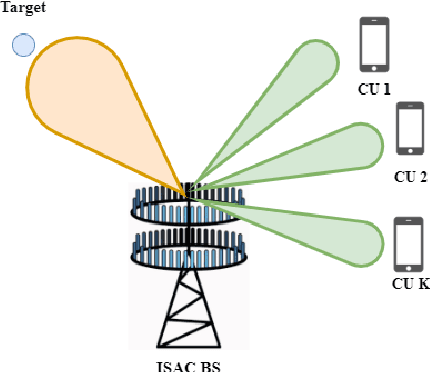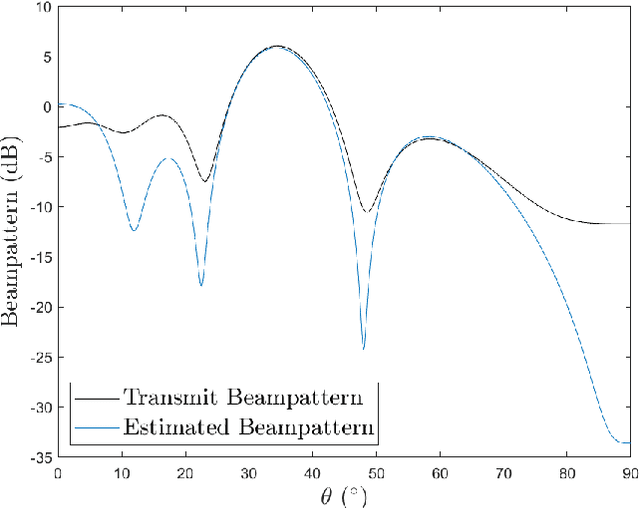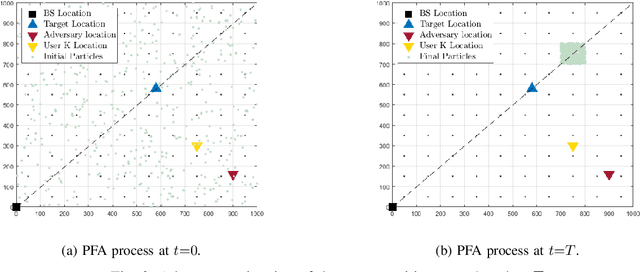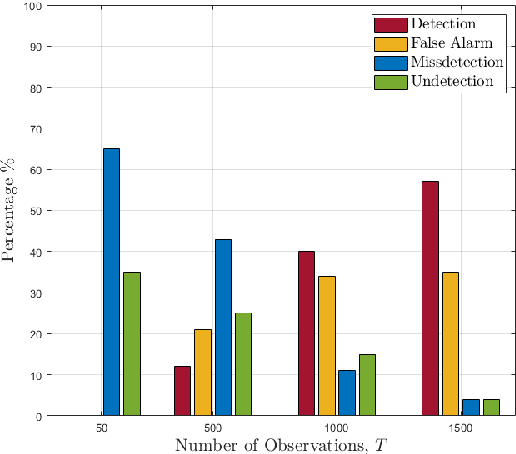Isabella W. G. da Silva
Cell-Free Massive MIMO-Based Physical-Layer Authentication
Aug 27, 2025Abstract:In this paper, we exploit the cell-free massive multiple-input multiple-output (CF-mMIMO) architecture to design a physical-layer authentication (PLA) framework that can simultaneously authenticate multiple distributed users across the coverage area. Our proposed scheme remains effective even in the presence of active adversaries attempting impersonation attacks to disrupt the authentication process. Specifically, we introduce a tag-based PLA CFmMIMO system, wherein the access points (APs) first estimate their channels with the legitimate users during an uplink training phase. Subsequently, a unique secret key is generated and securely shared between each user and the APs. We then formulate a hypothesis testing problem and derive a closed-form expression for the probability of detection for each user in the network. Numerical results validate the effectiveness of the proposed approach, demonstrating that it maintains a high detection probability even as the number of users in the system increases.
CSI Acquisition in Cell-Free Massive MIMO Surveillance Systems
Oct 04, 2024Abstract:We consider a cell-free massive multiple-input multiple-output (CF-mMIMO) surveillance system, in which multiple multi-antenna monitoring nodes (MNs) are deployed in either observing or jamming mode to disrupt the communication between a multi-antenna untrusted pair. We propose a simple and effective channel state information (CSI) acquisition scheme at the MNs. Specifically, our approach leverages pilot signals in both the uplink and downlink phases of the untrusted link, coupled with minimum mean-squared error (MMSE) estimation. This enables the MNs to accurately estimate the effective channels to both the untrusted transmitter (UT) and untrusted receiver (UR), thereby yielding robust monitoring performance. We analyze the spectral efficiency (SE) performance of the untrusted links and of the monitoring system, taking into account the proposed CSI acquisition and successive MMSE cancellation schemes. The monitoring success probability (MSP) is then derived. Simulation results show that the CF-mMIMO surveillance system, relying on the proposed CSI acquisition scheme, can achieve monitoring performance close to that achieved by having perfect CSI knowledge of the untrusted link (theoretical upper bound), especially when the number of MNs is large.
Performance of UAV-based Cell-free mMIMO ISAC Networks: Tethered vs. Mobile
May 10, 2024Abstract:The employment of unmanned aerial vehicles (UAVs) aligned with multistatic sensing in integrated sensing and communication (ISAC) systems can provide remarkable performance gains in sensing, by taking advantage of the cell-free massive multiple-input multiple-output (mMIMO) architecture. Under these considerations, in this paper, the achievable sensing signal-to-noise-plus-interference ratio (SINR) of a cell-free mMIMO ISAC UAV-based network is evaluated for two different deployments of UAVs, namely, mobile and tethered. In both scenarios, a transmit precoder that jointly optimizes the sensing and communication requirements subjected to power constraints is designed. Specifically, for the scenario with mobile UAVs, beyond the transmit precoding, we also optimize the position of the transmit UAVs through particle swarm optimization (PSO). The results show that, although tethered UAVs have a more efficient power allocation, the proposed position control algorithm for the mobile UAVs can achieve a superior gain in terms of sensing SINR.
Multi-Static ISAC in Cell-Free Massive MIMO: Precoder Design and Privacy Assessment
Oct 03, 2023Abstract:A multi-static sensing-centric integrated sensing and communication (ISAC) network can take advantage of the cell-free massive multiple-input multiple-output infrastructure to achieve remarkable diversity gains and reduced power consumption. While the conciliation of sensing and communication requirements is still a challenge, the privacy of the sensing information is a growing concern that should be seriously taken on the design of these systems to prevent other attacks. This paper tackles this issue by assessing the probability of an internal adversary to infer the target location information from the received signal by considering the design of transmit precoders that jointly optimizes the sensing and communication requirements in a multi-static-based cell-free ISAC network. Our results show that the multi-static setting facilitates a more precise estimation of the location of the target than the mono-static implementation.
Privacy Performance of MIMO Dual-Functional Radar-Communications with Internal Adversary
Feb 13, 2023



Abstract:The co-design of radar sensing and communications in dual-functional radar communication systems brings promising advantages for next generation wireless networks by providing gains in terms of the efficient and flexible use of spectrum, reduced costs, and lower energy consumption than in two separate systems. Besides the challenges associated with the conciliation of the conflicting requirements to perform wireless communication and radar sensing in a real-time cooperation, privacy issues represent a cause of concern as the co-design can let the network prone to active attacks. This paper tackles this issue by evaluating the associated privacy risks with the design of transmit precoders that simultaneously optimise both the radar transmit beampattern and the signal-to-interference-plus-noise at the communication users. Our results show that if a malicious user can infer the transmitted precoder matrix with a certain accuracy, there is a reasonable risk of exposure of the location of the target and privacy breaches.
 Add to Chrome
Add to Chrome Add to Firefox
Add to Firefox Add to Edge
Add to Edge